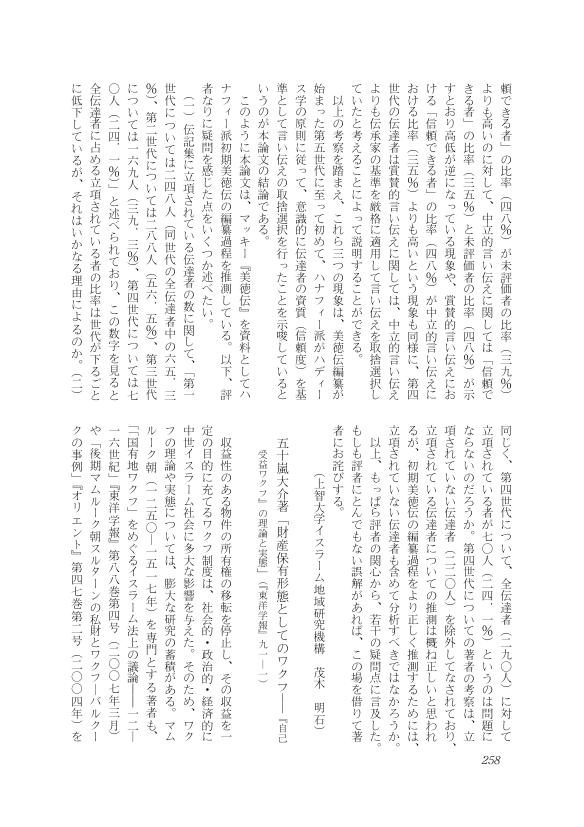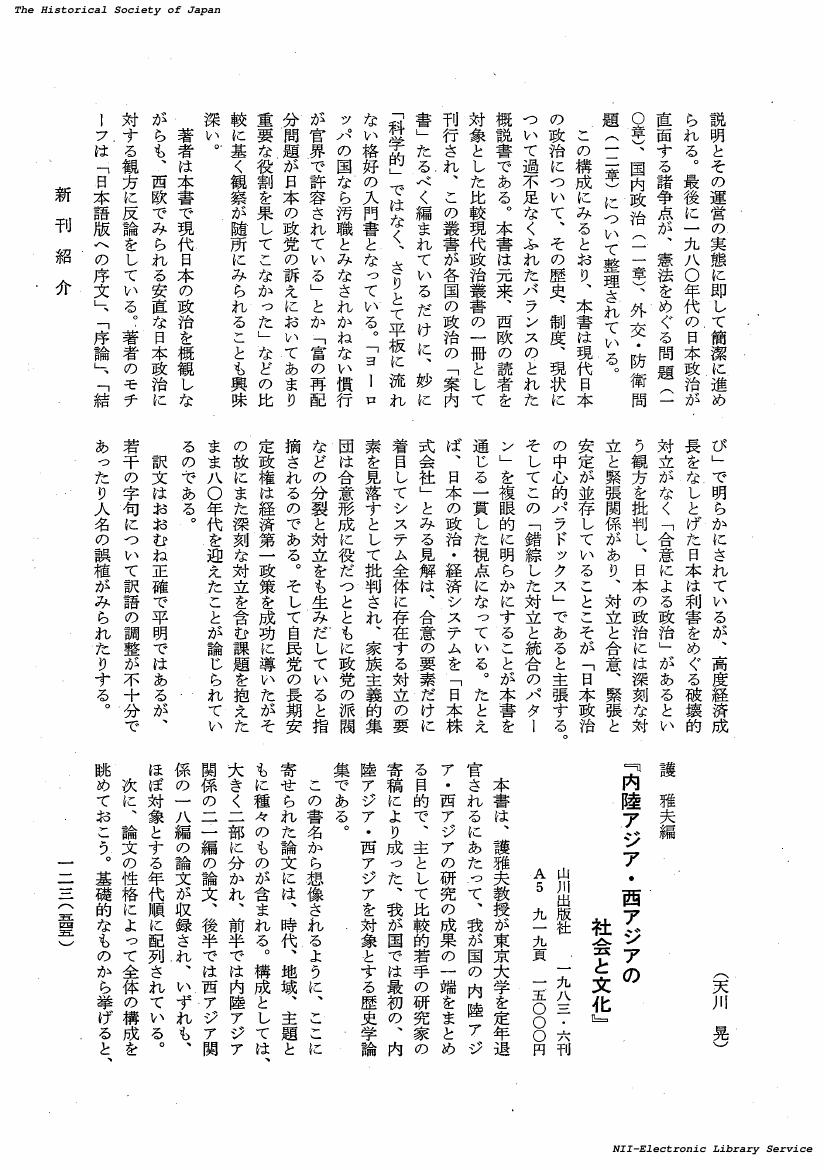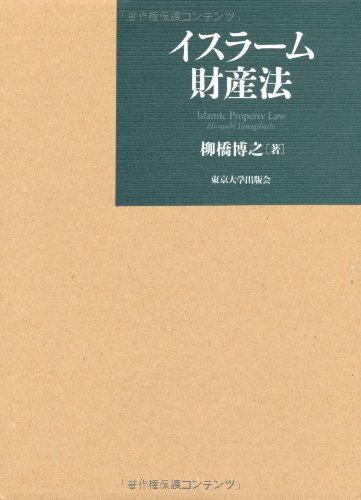6 0 0 0 OA 最近のイスラーム法制史研究―ここ二〇年間を中心として―
- 著者
- 柳橋 博之
- 出版者
- 法制史学会
- 雑誌
- 法制史研究 (ISSN:04412508)
- 巻号頁・発行日
- vol.2004, no.54, pp.81-113,en13, 2005-03-30 (Released:2010-05-10)
Roughly speaking, studies on Islamic law in the West have been centered around four theses advanced or elaborated by Joseph Schacht (1902-69), represented, among others, in his two monographs, The Origins of Muhammadan Jurisprudence (1950) and Introduction to Islamic Law (1964).First, the formation of Islamic law was a slow process in which the precepts of the Qur'an were gradually extended to cover the subject matters that they do not explicitly cover. In the first centuries of Islam, the popular practice and the Umayyad administrative regulations provided the materials for the nascent Islamic law.Second, in the first half of the eighth century, "the ancient schools of law" were formed in a number of centers of jurisprudence. They represented the average doctrine of each region, but it did not take long before the doctrines were projected back to several past authorities of jurisprudence. This phenomenon preceded the formation of personal schools of law, which were characterized by the adherence to a particular authority.Third, the process of projecting back of doctrine to the past authorities culminated in the fabrication of a large number of the Prophetic hadith (words and deeds of the Prophet), which were finally regarded as second only to the Qur'an as the basis of Islamic law.Fourth, once brought to perfection by the tenth century, Islamic law suffered no substantial change in the following millennium, which phenomenon was known as "the closing of gate of ijtihad (independent reasoning)."Recent studies based on a large number of sources published in the last twenty years and manuscripts that have become accessible to students of Islamic studies have modified these theses. As for the first thesis, recent studies have clarified in details the process during which individual rules were formed in the first two centuries of Islam. Regarding the second thesis, the problem of transition from the regional school to the personal school has been discussed based on the analysis of different kinds of sources, such as biography or works of positive law. The third thesis concerning the authenticity of the Prophetic sunna did not cease to be one of the most disputed subjects of Islamic law. The fourth thesis is no longer maintained, particularly after Wael B. Hallaq published a number of important treaties that shed light on the elaboration of science of theoretical bases of Islamic law.It should be noted that many studies have been undertaken that are focused on the relationship between Islamic law and the medieval and modern Islamic societies.In Japan, it was not until the middle of the eighties that study of Islamic law was undertaken on the basis of the original texts, although a few historians had used sporadically legal sources. Now a number of legal texts or works related to Islamic law have been translated into Japanese, such as the Shìhs of al-Bukhari (1993-94) and Muslim b. H ajjaj (1998), The Ordinances of Government of al-Mawardi (1981-89, of which a revised edition will appear in a couple of years), al-Raw d al-murbi' of the Hanbali jurist al-Bahutì (2002-) and Ma'alim al-din wa-maladh al-mujtahidin of the Shi'i jurist Ibn Zayn al-Din (1985).A History of Islamic Law of HORII Satoe (2004) is the first work in Japanese that deals with the development of the law since its formation in the seventh century up to the present day. It deserves to be mentioned because it assigned a large portion to the legal development since the tenth century, when Islamic law was brought to perfection with the four Sunni schools of law being established. Few scholars are specialized in the theoretical foundation of law (u s ul al-fiqh), but studies by Wael B.Hallaq and 'Abd al-Wahhab Khallaf have been translated.
5 0 0 0 OA 五十嵐大介著「財産保有形態としてのワクフ—『自己受益ワクフ』の理論と実態」
- 著者
- 柳橋 博之
- 出版者
- 法制史学会
- 雑誌
- 法制史研究 (ISSN:04412508)
- 巻号頁・発行日
- vol.60, pp.258-260, 2011-03-30 (Released:2017-05-02)
- 著者
- 柳橋 博之
- 出版者
- 公益財団法人 史学会
- 雑誌
- 史学雑誌 (ISSN:00182478)
- 巻号頁・発行日
- vol.93, no.4, pp.545-546, 1984-04-20 (Released:2017-11-29)
2 0 0 0 OA ハナフィー派法学の若干の解釈上の問題について
- 著者
- 柳橋 博之
- 出版者
- 一般社団法人 日本オリエント学会
- 雑誌
- オリエント (ISSN:00305219)
- 巻号頁・発行日
- vol.36, no.2, pp.34-48, 1993 (Released:2010-03-12)
La tendence extrêmement formaliste du droit hanafite rend le plus souvent difficile d'interpréter ses solutions positives. Cette difficulté est aggravée par le fait que les premiers juristesn'en expliquent pas les motivations.Voici deux exemples qui en fournissent une bonne illustration.(1) En matière de responsabilité délictuelle, certains des hanafis, ne reconnaissant que difficilement comme étant établi le lien de causalité entre le fait dommageable et la conséquence mauvaise, ne font encourir aucune responsabilité à celui qui a ouvert le cage, au cas où l'oiseau qui s'y trouve s'enfuirait.(2) En ce qui concerne la vente portant sur un corps certain, les hanafis ne permettent pas à l'acheteur de disposer de la chose vendue avant qu'il n'en ait pris la livraison, car le vendeur ne détient pas la chose en tant que mandataire de l'acheteur, ce qui rend impossible, sur le plan juridique, la livraison immédiate de la chose au second acquéreur.
2 0 0 0 OA シャイバーニー『アスル』の編纂過程
- 著者
- 柳橋 博之
- 出版者
- 法制史学会
- 雑誌
- 法制史研究 (ISSN:04412508)
- 巻号頁・発行日
- vol.58, pp.1-46,en3, 2009-03-30 (Released:2014-03-31)
カルダーによれば、九世紀の法学テキストが一般にそうであったように、現在我々が目にするような『アスル』のテキストは、最初に弟子が師の言葉を書き取り、それにたいしてその弟子自身またはそれ以後の編纂者が次々と加筆、修正、並べ替えなどの編集を積み重ねる過程を経て確定され、シャイバーニーの著作とされた。ハッラークも、法源学の著作を資料として用いて、九世紀末までの法学者は、「導出」によって学祖の説から二次的に導き出した説を、学祖の説と識別不能な形でテキスト中に取り込んだとしている。しかし両者とも、用いている資料に由来する制約から、そのような著述の方法がいつどのようにして始まったのかについては述べていない。本稿は、その過程を、カイロ写本、シャイバーニー(八〇五年没)『アスル』「賃約の書」を分析することによって推察する試みである。この写本の一部は、これまでに刊本になっている最終版『アスル』が成立する前の編纂段階を反映している点で、その編纂過程を知る上で有益な情報をもたらしてくれる。その分析の結果、つぎのような結論を得た。1.原『アスル』は、シャイバーニーの口述である。2.そのつぎの段階―編纂の前期―では、原『アスル』を補足・敷衍する形で設例が付け加えられるが、テキストとしては原『アスル』とは切り離された形で作成された3.最終段階―編纂の後期―では、テキストの混交が行われ、シャイバーニー以降に作成されたテキストが原『アスル』に埋め込まれている。このように、『アスル』の前期の編纂段階においては新しいテキストは古いテキストとは別個に作成され、また異なる文体が用いられたが、それ以降の編纂段階においてテキストの統一ないし混交が行われ、校訂本の多くの書に見られるようなテキストが確立したのである。このことは、前期の編纂者が学祖の説とそれ以降の学説を区別しようとしていたのにたいして、後期の編纂者には、学祖の説とそこから「導出」によって導かれる学説を全体として一つの体系―つまりはハナフィー派学説―とみなす傾向が見られると解することができよう。
2 0 0 0 OA 現代中東における近代以前イスラーム思想の権威的テキストの受容と影響
中東三地域(アラブ・イラン・トルコ地域)全般について、竹下がイスラーム神秘思想(イブン・アラビーおよびその系統)のテキスト、オスマン帝国領域について、柳橋が法学分野のシャイバーニーのテキストおよびスンナ派四法学派の権威的テキスト、イラン・シーア派地域について、鎌田が神秘思想に関するモッラー・サドラーのテキスト、吉田が伝承学のマジュリスィーのテキスト、エジプト、アラブ地域について、青柳がガザーリーの神学テキスト、これらの主要なテキストに関し現代における受容と影響を考察する論文、著作を成果としてまとめた。
1 0 0 0 イスラーム財産法 = Islamic property law
1 0 0 0 IR ハディースの計量的分析の試み : ブハーリー『サヒーフ』を資料として
- 著者
- 柳橋 博之
- 出版者
- 西南アジア研究会
- 雑誌
- 西南アジア研究 = Bulletin of the Society for Western and Southern Asiatic Studies, Kyoto University (ISSN:09103708)
- 巻号頁・発行日
- no.90, pp.77-93, 2020
Although several researchers have been interested in the issue of textual variation of hadith, few studies have been undertaken to determine statistically the date and the process of generation of hadith variants. This study seeks to present three initial mathematical models that approximate the processthrough which variantsof the whole hadithsrecorded in al-Bukhārī's Ṣaḥīḥ were generated, under the assumption that many of the recorded hadiths were intentionally or unintentionally (i. e., by error) reformulated once or more with almost the same probability since they first entered circulation. Namely, by counting Bn, i. e., the number of hadith groupsthat comprise n variants, we obtain a sequence (Bn). Notably, (Bn) formsapproximately a geometrical sequence with a common ratio of 0.63. Based on this finding, we can establish a recurrence formula containing two or three parameters that determines the numbersof hadithscompris ing a certain number of variantsat a certain point in time each. By setting these parameters to appropriate values, we can establish two models that closely approximate (Bn).
1 0 0 0 OA アラウィー派主要教義と宗派対立に関する思想史的研究
1 0 0 0 モロッコ国制におけるイスラム法の位置
- 著者
- 柳橋 博之
- 出版者
- 日本中東学会
- 雑誌
- 日本中東学会年報 (ISSN:09137858)
- 巻号頁・発行日
- no.8, pp.189-210, 1993-03-31
モロッコの国家秩序の中におけるイスラム法の位置は,保護統治以前(1912年まで),保護統治期(1912-1956年),独立後(1956年以降)にこれを分けて考察することができる。先ず保護統治以前には,他のイスラム諸地域と同じく,狭義のイスラム法,すなわちモロッコの場合にはマーリク派法学とカーディーの裁判権は,シャリーアの解釈権や裁判権を主張するマフザン(中央政府)との対立の中で,次第に狭められ,僅かに身分法と一部の不動産訴訟においてその適用や裁判管轄が残ったに過ぎなかった。その他の分野では,パシャやカーイドといったマフザン(中央政府)の行政官が,しばしば恣意的とされる裁判を行っており,またマフザンの権威の及ばない地域も広く,そこでは慣習法が行われていた。フランスによる保護統治下では,マフザンとマーリク派法学ないしはカーディーの間の対立が緩和された。それはマフザンがフランス政府による過度の改革を嫌い,そのような改革を避けるために,改革がイスラムないしはシャリーアという,宗教に関する事項に干渉することになるという口実を設けたためであり,このために身分法や不動産訴訟などの管轄権が明文によりカーディーに留保された他,カーディー法延の改革は進まず,また少数ながら契約・債権法にはマーリク派の学説が導入された。独立後は,政府は,近代国家の概念に基づいて,マーリク派法学とカーディー法廷を国家体制の中に組み込む政策を採った。それは具体的には,司法組織の改革によって裁判組織が一本化されたことや,従来マーリク派の法学者が独占していた身分法規定の法典編纂などの形で現れている。
1 0 0 0 イスラーム法形成期におけるタウリヤとイシュラーク
- 著者
- 柳橋 博之
- 出版者
- 日本中東学会
- 雑誌
- 日本中東学会年報 (ISSN:09137858)
- 巻号頁・発行日
- no.19, pp.27-43, 2003-09-30
後世のハナフィー派はタウリヤを、「信頼売買」の一つとして定義している。同派は、タウリヤにおいては、売主が目的物の取得に要した原価を表示し、それと同額で転売することから、これを商取引に疎い買主を保護することを目的とする売買と解したのである。しかしイスラーム法形成期の8世紀の少なくとも初頭においては、タウリヤが締結される場合、買主が目的物を転売することによって得られる転売益について売主が一定の取り分を留保することが予定されており、従ってタウリヤは一種の組合契約であった。しかし、タウリヤは形式上は売買であって、所有権を移転する機能を有することから、その締結後、ないしは少なくとも目的物の引渡しが完了した後には、その滅失・毀損について売主は危険を負担しなかった。しかし、「危険を負担しない物から利益を得てはならない」という原則が8世紀前半に導入されることによって、このいわば原タウリヤ売買は非合法化され、それに代わるものとして、イシュラークが導入された。
- 著者
- 柳橋 博之
- 出版者
- 日本イスラム協会
- 雑誌
- イスラム世界 (ISSN:03869482)
- 巻号頁・発行日
- no.65, pp.81-86, 2005-10


